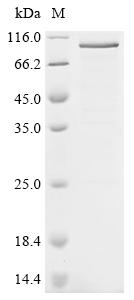Recombinant Mouse Nuclear factor erythroid 2-related factor 2 (Nfe2l2)
CAT:
399-CSB-EP726674MO-03
Size:
1 mg
Price:
Ask
- Availability: 24/48H Stock Items & 2 to 6 Weeks non Stock Items.
- Dry Ice Shipment: No




Recombinant Mouse Nuclear factor erythroid 2-related factor 2 (Nfe2l2)
- CAS Number: 9000-83-3
- Gene Name: Nfe2l2
- UniProt: Q60795
- Expression Region: 1-597aa
- Organism: Mus musculus
- Target Sequence: MMDLELPPPGLQSQQDMDLIDILWRQDIDLGVSREVFDFSQRQKDYELEKQKKLEKERQEQLQKEQEKAFFAQFQLDEETGEFLPIQPAQHIQTDTSGSASYSQVAHIPKQDALYFEDCMQLLAETFPFVDDHESLALDIPSHAESSVFTAPHQAQSLNSSLEAAMTDLSSIEQDMEQVWQELFSIPELQCLNTENKQLADTTAVPSPEATLTEMDSNYHFYSSISSLEKEVGNCGPHFLHGFEDSFSSILSTDDASQLTSLDSNPTLNTDFGDEFYSAFIAEPSDGGSMPSSAAISQSLSELLDGTIEGCDLSLCKAFNPKHAEGTMEFNDSDSGISLNTSPSRASPEHSVESSIYGDPPPGFSDSEMEELDSAPGSVKQNGPKAQPAHSPGDTVQPLSPAQGHSAPMRESQCENTTKKEVPVSPGHQKAPFTKDKHSSRLEAHLTRDELRAKALHIPFPVEKIINLPVDDFNEMMSKEQFNEAQLALIRDIRRRGKNKVAAQNCRKRKLENIVELEQDLGHLKDEREKLLREKGENDRNLHLLKRRLSTLYLEVFSMLRDEDGKPYSPSEYSLQQTRDGNVFLVPKSKKPDTKKN
- Tag: N-terminal 6xHis-tagged
- Source: E.coli
- Field of Research: Cardiovascular
- Assay Type: Developed Protein
- Relevance: Transcription factor that plays a key role in the response to oxidative stress: binds to antioxidant response (ARE) elements present in the promoter region of many cytoprotective genes, such as phase 2 detoxifying enzymes, and promotes their expression, thereby neutralizing reactive electrophiles. In normal conditions, ubiquitinated and degraded in the cytoplasm by the BCR (KEAP1) complex. In response to oxidative stress, electrophile metabolites inhibit activity of the BCR (KEAP1) complex, promoting nuclear accumulation of NFE2L2/NRF2, heterodimerization with one of the small Maf proteins and binding to ARE elements of cytoprotective target genes. The NFE2L2/NRF2 pathway is also activated in response to selective autophagy: autophagy promotes interaction between KEAP1 and SQSTM1/p62 and subsequent inactivation of the BCR (KEAP1) complex, leading to NFE2L2/NRF2 nuclear accumulation and expression of cytoprotective genes. May also be involved in the transcriptional activation of genes of the beta-globin cluster by mediating enhancer activity of hypersensitive site 2 of the beta-globin locus control region. Also plays an important role in the regulation of the innate immune response. It is a critical regulator of the innate immune response and survival during sepsis by maintaining redox homeostasis and restraint of the dysregulation of pro-inflammatory signaling pathways like MyD88-dependent and -independent and TNF-alpha signaling. Suppresses macrophage inflammatory response by blocking pro-inflammatory cytokine transcription and the induction of IL6. Binds to the proximity of pro-inflammatory genes in macrophages and inhibits RNA Pol II recruitment. The inhibition is independent of the Nrf2-binding motif and reactive oxygen species level. Represses antiviral cytosolic DNA sensing by suppressing the expression of the adapter protein STING1 and decreasing responsiveness to STING1 agonists while increasing susceptibility to infection with DNA viruses.
- Purity: Greater than 85% as determined by SDS-PAGE.
- Activity: Not Test
- Length: Full Length
- Form: Liquid or Lyophilized powder
- Buffer: If the delivery form is liquid, the default storage buffer is Tris/PBS-based buffer, 5%-50% glycerol. If the delivery form is lyophilized powder, the buffer before lyophilization is Tris/PBS-based buffer, 6% Trehalose, pH 8.0.
- Reconstitution: We recommend that this vial be briefly centrifuged prior to opening to bring the contents to the bottom. Please reconstitute protein in deionized sterile water to a concentration of 0.1-1.0 mg/mL.We recommend to add 5-50% of glycerol (final concentration) and aliquot for long-term storage at -20℃/-80℃. Our default final concentration of glycerol is 50%. Customers could use it as reference.
- Molecular Weight: 73.0 kDa
- Storage Conditions: The shelf life is related to many factors, storage state, buffer ingredients, storage temperature and the stability of the protein itself. Generally, the shelf life of liquid form is 6 months at -20℃/-80℃. The shelf life of lyophilized form is 12 months at -20℃/-80℃.
